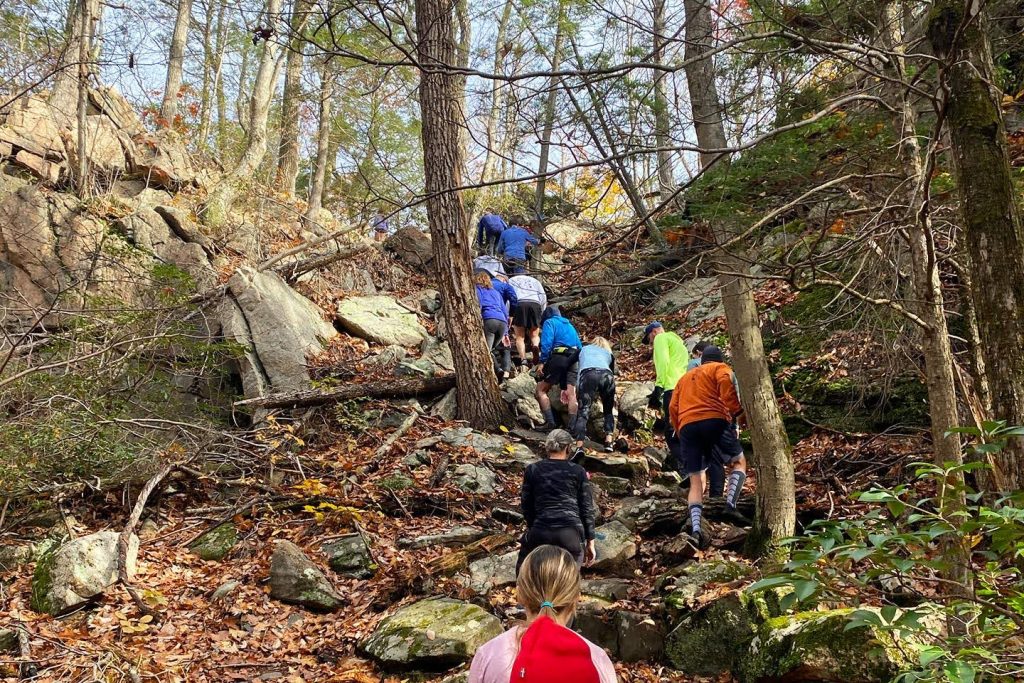Trail running has exploded in popularity in recent years and, as a result, so too have trail races. In the Northeast alone there are dozens—if not hundreds—of trail races, each with a character of their own, imbued, of course, by their respective natural surroundings. While the races are as varied as the trails themselves, many of the region’s premier events have a common element: the mountains and all the technical terrain, grueling climbs, and unpredictable weather therein.
The traditional methods of preparing for a running race are lacking. Mountain races require mountain-specific training—which, if you’re a flatlander or a city-dweller, presents a bit of a challenge. Fortunately, there are alternatives. Although nothing will prepare you for a mountain race like the mountains themselves, the following will, at the very least, ensure you don’t get smoked on your next mountain race.

Making a Mountain Race Training Plan
First thing first, make a plan. Not all mountain races are the same, and the one you sign up for is going to dictate just what you need to do to effectively train.
Distance is the most obvious characteristic to consider when planning your training, but as mentioned, elevation gain and terrain are also incredibly important. So too is the type of mountain race you’re signing up for. Training for a vertical kilometer (which is exactly what it sounds like: one kilometer, straight uphill) is going to look a lot different than training for a 50-miler. Keep this in mind as you build your plan—the types of workouts you do, their frequency, and the overall time commitment will vary greatly depending on your objective.
Simulating the Vert
Regardless of what type of mountain race you’re looking at, preparing for that elevation gain is going to be critical. If you don’t have easy access to trails with a lot of vertical, fear not—“backyard steeps” abound. Seek out whatever will get your heart pumping nearby and climb it—wherever you’re located, a small hill or a set of stairs is surely close. Climb these, on repeat, in addition to running your local trails. Build your reps as you would your mileage, adding weight as needed.

“Benchmark” Runs
A lot of traditional training programs will encourage you to run a race or two in advance of the big event. If you’re training for a half marathon, for example, there will likely be a 5K and 10K race in the mix; if you’re training for a full marathon, then you’ll likely have a half marathon on the docket. The idea is to, at some point in your training, get a feel for what race day will be like, and the same logic applies here: during your training, you should be simulating the terrain you’ll be racing on.
There’s not really anywhere in the Northeast that’s more than a couple hours’ drive from the mountains, so take your pick. For those of us in southern New England or downstate New York, the Catskills and the Taconics are within arm’s reach and offer miles and miles of burly trails that’ll get that elevation gain in. If your race is on the more technical side of things, and you’re looking to hone your scrambling skills, Breakneck Ridge in New York and Mount Monadnock in New Hampshire are both relatively nearby and excellent destinations in their own right.
Pick your spots and make sure one or two of your training runs are the real deal.

Local Trail Races
In that same spirit, the traditional intent—running a smaller race to simulate your race day experience—still holds water. A local race, in addition to getting you more miles on the trail, goes a long way in helping you mentally prepare for your objective. Pacing, fueling, and sharing the trail with a couple hundred other runners are all part of the deal, and very different from the solitary miles and hill climbs of the bulk of your training. Find a race in your neck of the woods and build it into your plan.

Measuring Progress
As you log more mileage and gain more elevation in your workouts, measuring your progress becomes more essential and more rewarding.
Tracking your workouts with a smartwatch or a smartphone will give you a wealth of data that you can use to your advantage as race day approaches. You can use apps like Strava to distill this data into tangible performance indicators that can help you tailor your training, manage the load you’re taking on, and recover appropriately.
Keeping a journal, however analog, is also incredibly helpful. How you’re feeling after a training session—and what you should be doing as a result—is often more nuanced than a pace or a heart rate are able to communicate on their own. Plus, over the course of a long training cycle, it’s very satisfying to look back at everything that’s gone into your objective.

The Bucket List Mountain Races of the Northeast
Ready to get to it? Trawling Ultrasignup is a great place to start, but here are some ideas to help stoke that fire. The following are some of the toughest, coolest, and all-around most fun trail races the Northeast has to offer:
- Breakneck Point Races, Hudson Highlands, NY
- Chocorua Mountain Race, White Mountains, NH
- Escarpment Trail Run, Catskills, NY
- Kilkenny Ridge Race, White Mountains, NH
- Quebec Mega Trail, QC
- Whiteface Mountain Races, Adirondacks, NY
- Vermont 100, Green Mountains, VT
John Lepak
John Lepak is an art director, graphic designer, and weekend mountaineer. He hasn’t met a rock scramble he didn’t like, and spends his free time either in the mountains or obsessively cooking Mexican food. When John isn’t pushing pixels, crushing miles, or making the best carnitas caseras you’ve ever tasted, you can find him living the dream in the Connecticut woods with his family. Follow him at @jhlepak.
Related Posts
April 2, 2024
10 Tips for Mountain Biking Etiquette During Mud Season
One rough spring could ruin the…




